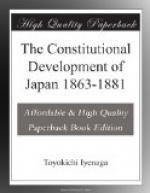The Shogun began to make a compromise to unite the Emperor’s power and the Shogun’s, by taking the sister of the Emperor for his wife.
Meanwhile great events were taking place in the southern corner of Kiushiu and on the promontory of Shikoku, events which were to effect great changes in men’s ideas. These were the bombardments of Kagoshima and of Shimonosheki, the first on August 11, 1863, the second on September 5, 1864. I shall not dwell here on the injustice of these barbarous and heathenish acts of the so-called civilized and Christian nations; for I am not writing a political pamphlet. But impartially let us note the great effects of these bombardments.
I. These conflicts showed on a grand but sad scale the weakness of the Daimios, even the most powerful of them, and, on the other hand, the power of the foreigners and their rifled cannon and steamers. The following Japanese memorandum expresses this point: “Satsuma’s eyes were opened since the fight of Kagoshima, and affairs appeared to him in a new light; he changed in favor of foreigners, and thought now of making his country powerful and completing his armaments."[8]
The Emperor also wrote in a rather pathetic tone to the Shogun touching the relative strength of the Japanese and the foreigners: “I held a council the other day with my military nobility (Daimios and nobles), but unfortunately inured to the habits of peace, which for more than two hundred years has existed in our country, we are unable to exclude and subdue our foreign enemies by the forcible means of war....
“If we compare our Japanese ships of war and cannon to those of the barbarians, we feel certain that they are not sufficient to inflict terror upon the foreign barbarians, and are also insufficient to make the splendor of Japan shine in foreign countries. I should think that we only should make ourselves ridiculous in the eyes of the barbarians."[9]
From the time of the bombardment, Satsuma and Choshiu began to introduce European machinery and inventions, to employ skilled Europeans to teach them, and to send their young men to Europe and America.
Ii. These bombardments showed the necessity of national union. Whether she would repel or receive the foreigner, Japan must present a united front. To this end, great change in the internal constitution of the empire was needed; the internal resources of the nation had to be gathered into a common treasury; the police and the taxes had to be recognized as national, not as belonging to petty local chieftains; the power of the feudal lords had to be broken in order to reconstitute Japan as a single strong state under a single head. These are the ideas which led the way to the Restoration of 1868. Thus the bombardments of Kagoshima and Shimonosheki may be said to have helped indirectly in the Restoration of that year. But before we proceed to the history of the Restoration, let us examine what were the great Councils of Kuges and Daimios, which were sometimes convened during the period from 1857 to 1868.




